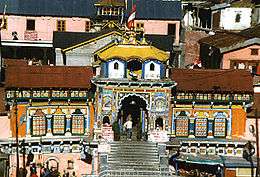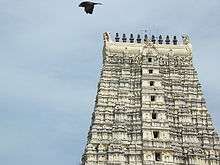Char Dham
| Char Dham
Dwarka • Puri |
|---|
Char Dham (literally: 'the four abodes/seats') are the names of four pilgrimage sites in India that are widely revered by Hindus. It comprises Badrinath, Dwarka, Puri and Rameswaram. It is considered highly sacred by Hindus to visit Char Dham during one's lifetime. The Char Dham defined by Adi Shankaracharya consists of four Vaishnavite pilgrimages.[1][2]
The other pilgrimages sites in the Indian state of Uttarakhand viz. Yamunotri, Gangotri, Kedarnath, and Badrinath were known as Chota Char Dham to differentiate them from the bigger circuit of Char Dham sites, but after the mid-20th century they have been also referred to as the Char Dham.[3][4][5][6]
Historical description
According to Hindu mythology, Badrinath became prominent when Nar-Narayan, an incarnation of Vishnu did Tapasya there. At that time that place was filled with Berry trees. In Sanskrit language they are called Badri, so the place was named Badrika-Van i.e. the forest of Berry. The particular spot where the Nar-Narayan did Tapasya, a large Berry tree formed covering him to save him from rain and sun. Local believe mata Lakshmi became the Berry tree to save Narayan. Post Tapasya, Narayan said, people will always take her name before his name, hence Hindus always refer "Lakshmi-Narayan ". It was therefore called Badri-Nath i.e. the Lord of Berry forest. This all happened in the Sat-Yuga. So the Badrinath came to be known the first Dham.
The second place, the Rameshwram got its importance in the Treta-Yug when Lord Rama built a Shiv-ling here and worshiped it to get the blessings of Lord Shiva. The name Rameshwram means "the God of Lord Rama". Rama himself is considered an incarnation of Lord Vishnu.
The third Dhaam Dwarka got its importance in Dwapar Yug when Lord Krishna another incarnation of Lord Vishnu, made Dwarka his residence instead of Mathura, his birthplace.[7]
The Four Shankaracharya Peeth (Seats) at the Chaar Dham school of Hinduism, created at least four Hindu monastic institutions. He organised the Hindu monks under four Maṭhas (Sanskrit: मठ) (monasteries), with the headquarters at Dvārakā in the West, Jagannatha Puri in the East, Sringeri Sharada Peetham in the South and Badrikashrama in the North.[8]
The table below gives an overview of the four Amnaya Mathas founded by Adi Shankara, and their details.[9]
| Shishya (lineage) |
Direction | Maṭha | Mahāvākya | Veda | Sampradaya |
|---|---|---|---|---|---|
| Padmapāda | East | Govardhana Pīṭhaṃ | Prajñānam brahma (Consciousness is Brahman) | Rig Veda | Bhogavala |
| Sureśvara | South | Sringeri Śārada Pīṭhaṃ | Aham brahmāsmi (I am Brahman) | Yajur Veda | Bhūrivala |
| Hastāmalakācārya | West | Dvāraka Pīṭhaṃ | Tattvamasi (That thou art) | Sama Veda | Kitavala |
| Toṭakācārya | North | Jyotirmaṭha Pīṭhaṃ | Ayamātmā brahma (This Atman is Brahman) | Atharva Veda | Nandavala |
The four associated places of the Char dhaams
In Hindu Puranas Hari (Vishnu) and Har (Shiv) are referred as eternal friends. It is said wherever there resides Lord Vishnu, Lord Shiva also resides nearby. Chaar Dhaams are also not exception of this. So the Kedarnath is considered as the pair of Badrinath, Rangnath Swami is considered the pair of Rameshwaram. Somnath is considered as the pair of Dwarka. However one thing is also to be noted here that according to some traditions the Char Dham are Badrinath, Rangnath-Swami, Dwarka and Jagannath-Puri all the four of which are Vaishnav sites and their associated places are Kedarnath, Rameshwaram, Somnath and Lingaraja Temple, Bhubaneswar (or may be Gupteshwar) respectively.
Pilgrimage details
1. Puri
Puri located at the east, is located in the state of Odisha, India. Puri is one of the oldest cities in the eastern part of the country. It is situated on the coast of the Bay of Bengal. The main deity is Shri Krishna, celebrated as Lord Jagannatha. It is the only shrine in India, where goddess, Subhadra, sister of Lord Krishna is worshipped along with her brothers, Lord Jagannatha and Lord Balabhadra. The main temple here is about 1000 years old and constructed by Raja Choda Ganga Deva and Raja Tritiya Ananga Bhima Deva. Puri is the site of the Govardhana Matha, one of the four cardinal institutions or Mathas established by Adi Shankaracharya. Brahma, Vishnu & Maheswara three are together in all-time every place. In Kali yuga Sreemandir as jagannath temple in Puri. Jagannath-Vishnu, Balabhadra-Maheswara & Subhadra-Brahma. This is the plume for Oriya people to celebrate a special day in this Dham which is known as Ratha Yatra ("Chariot Festival").[10][11]
2. Rameswaram
Rameswaram located in the South is in the Indian state of Tamil Nadu. It is situated in the Gulf of Mannar at the very tip of the Indian peninsula. According to legends, this is the place from where Lord Rama, built a bridge Ram Setu to Lanka. The Ramanatha Swamy Temple dedicated to Lord Shiva occupies a major area of Rameswaram. The temple is believed to have been consecrated by Shri Rama Chandra. Rameswaram is significant for the Hindus as a pilgrimage to Benaras is incomplete without a pilgrimage to Rameswaram. The presiding deity here is in the form of a Linga with the name Sri Ramanatha Swamy, it also is one of the twelve Jyotirlingas. Brahma, Vishnu & Maheswara three are together in all-time every place. Rama-Vishnu, Laxman-Brahma & Hanuman-Maheswara.
3. Dwarka
Dwarka located in the west is in the state of Gujarat, India. The city derives its name from the word "dvar" meaning door or gate in the Sanskrit language. It is located confluence to where the Gomti River merges into the Arabian Sea. However, this river Gomti is not the same Gomti River which is tributary of Ganga River The city lies in the westernmost part of India. The legendary city of Dwaraka was the dwelling place of Lord Krishna. It is believed that due to damage and destruction by the sea, Dvaraka has submerged six times and modern day Dwarka is the 7th such city to be built in the area.
4. Badrinath
Badrinath is located in the state of Uttarakhand. It is in the Garhwal hills, on the banks of the Alaknanda River. The town lies between the Nar and Narayana mountain ranges and in the shadow of Nilkantha peak (6,560m).
See also
References
- ↑ Destination Profiles of the Holy Char Dhams, Uttarakhand
- ↑ Gwynne, Paul (2009), World Religions in Practice: A Comparative Introduction, Oxford: Blackwell Publication, ISBN 978-1-4051-6702-4
- ↑ Char Dham of Garhwal India, by Joe Windless, Sarina Singh, James Bainbridge, Lindsay Brown, Mark Elliott, Stuart Butler. Published by Lonely Planet, 2007. ISBN 1-74104-308-5. Page 468.
- ↑ Chardham Yatra, by Savitri Dubey. Published by Alekh Prakashan. ISBN 978-81-88913-25-1
- ↑ Welcome To Alekh Prakashan Archived 23 December 2010 at the Wayback Machine.
- ↑ "Char Dham and Hemkund Sahib Yatra to restart from May 2014". IANS. news.biharprabha.com. Retrieved 24 April 2014.
- ↑ Chakravarti Mahadev-1994-The Concept of Rudra-Śiva Through The Ages-Delhi-Motilal Banarsidass-Second Revised. ISBN 81-208-0053-2
- ↑ "Archived copy". Archived from the original on 8 May 2012. Retrieved 2009-05-03.
- ↑ The Amnaya Peethams | Sringeri Sharada Peetham Archived 26 June 2006 at the Wayback Machine.
- ↑ Char Dham Yatra, by G. R. Venkatraman. Published by Bharatiya Vidya Bhavan, 1988.
- ↑ Brockman, Norbert C. (2011), Encyclopedia of Sacred Places, California: ABC-CLIO, LLC, ISBN 978-1-59884-655-3
| Wikimedia Commons has media related to Char Dham Temples. |




